This page aims to provide a comprehensive reference of hotels in New Lambton from 1869 to the present.
- New Lambton Hotel
- Hand of Friendship Hotel
- Sportsman’s Arms Hotel (1)
- Sportsman’s Arms Hotel (2)
- Nil Desperandum Hotel / Duckenfield Hotel
- Duke of Wellington Hotel
- Sunnyside Hotel
- General Roberts Hotel
- Blackbutt Hotel
This list covers hotels that were located in the area of New Lambton Municipal Council (1889-1938), shown by the white border in the image below. The current suburb of New Lambton is shaded in yellow. Note that the northernmost tip of the New Lambton municipality included a small part of present day Broadmeadow, which is why the Sunnyside Hotel is included in this page of New Lambton hotels.

The map below shows the location of Lambton Hotels. The four hotels that are still operating are shown in green, historical hotels are shown in red.

In documenting the history of hotels it is important to understand the roles of owners, lessees and licensees. The hotel owner is the person (or company) that owns the land and buildings upon the land. The owner may then lease the buildings to another person (or company) for the purpose of running a business such as a hotel. The hotel licensee is the person who is granted a liquor license by the government and is responsible for adhering to the liquor regulations. Sometimes the owner and licensee are the same person, but sometimes the owner, lessee and licensee are three different entities. For example, in 1878 for the New Lambton Hotel, the land was owned by the New Lambton Company, leased to Joseph Chinchen, and the hotel licensee was Enoch Davies.
The history of hotels can also be confusing in that the same hotel can have different names over time. For example, the Kotara Hotel was renamed to the Blackbutt Hotel in 1978. Sometimes a hotel name and license can be transferred to a different geographical location. For example, the Sportsman’s Arms Hotel first opened on Regent Street in 1870, but then moved to Hobart Road in 1903.
A further complication is the variant spellings of the licensee names. Where there are multiple spellings of a name and the correct spelling is uncertain, I have included variant spellings in square brackets. e.g. “Damerell [Damerill]”. Note that in the lists of licensees I have only included names up to about 1970, as online information about licensees after this date becomes sparse.
In the list below I have an entry for each hotel operating at a specific location. The hotels appear in order of the year they were first opened.
New Lambton Hotel (1869-1879)
The first hotel in New Lambton was the somewhat unimaginatively named “New Lambton Hotel”. It was erected on the south-west corner of Russell Rd and Regent St by Mr Hubbard of Hunter St Newcastle.
On our way home from the foot races, at Lambton, on Saturday last, we had an opportunity of paying a visit to the New Lambton Hotel, recently erected by Mr. Hubbard, of Hunter-Street. The building in question is certainly an excellent one, and, in every way, well adapted to the requirements of the place. The expeditious manner in which this hotel was put up is worthy, of notice. Less than four months ago, from the present time, the ground on which it stands was a wild, uncleared bush ; and the hotel has been open for nearly a month, so that, as a matter of fact, the hotel was only three months in course of erection. Of course this would be nothing out of the way if the site had been an accessible one — which it was not — the road to New Lambton being about as bad a one as there is in the whole district, and that is saying a good deal. The building is a two-story one, and appears to be well and faithfully built. It is nicely painted inside and out, and is really a very snug and comfortable place. The bar is commodious and airy, and in regard to attractiveness is not surpassed by any establishment in the city of Newcastle. On the upper floor of the hotel there is a large room, well adapted for public meetings and entertainments, and at the rear of the premises are stables to accommodate an almost unlimited number of horses. Altogether, the New Lambton Hotel is one of the very best hotels in any of the colliery townships.
The Newcastle Chronicle,17 August 1869.
Henry Lott, the first licensee of the hotel, was granted a publican’s licence in July 1869. His tenure at the hotel did not last long, only 9 months later in March 1870, the lessees (Hubbard and Chinchen) advertised for sale, the “license, stock, and furniture of the New Lambton Hotel.”
In May 1870 John Gordon announced in a large advertisement that he had taken on the New Lambton Hotel. His tenure was similarly short-lived and by March 1871 Hubbard and Chinchen were once again advertising the hotel for letting.
David Lewis was issued a publican’s licence commencing on 1 July 1871, followed by George Lowe who held the licence from 1 July 1874. In May 1875 George Lowe advertised “a sale by auction for household furniture and effects” at the New Lambton Hotel.
Thomas Hardy was issued the publican’s licence from 1 July 1875. In December 1876 the hotel had a narrow escape from being burned down, when a hanging kerosene lamp, without any apparent cause, suddenly exploded and splashed burning oil on the floor. Only the quick action of Thomas Hardy’s daughter in smothering the flames with a blanket prevented a serious conflagration.
In April 1877 the newspaper reported that the hotel was “about to change hands from Mr T Hardy to Mr Enoch Davies”. At a Police Court hearing in June 1880 “the license of the New Lambton Hotel, New Lambton, was cancelled, as the proprietor, Mr. Enoch Davis, was proved to have abandoned his licensed house.”
There is a final reference to the hotel on 15 October 1880, with an advertisement noting that “Mr T M Dalveen will address the electors … at the New Lambton Hotel”. As there is no evidence of any licensees after Enoch Davies cancellation, I can only assume that this is a reference to the hotel building, not the hotel as a licensed premises.
An article in September 1892 states that after the hotel was no longer licenced, the building was “used as a store and temperance hall.” Mentions of a Temperance Hall in New Lambton start appearing in Trove from September 1880, just a few months after the licence was removed.
In the period 1889 to 1892, the Lay Methodist Church of New Lambton met in the Temperance Hall before moving into their own church building in 1892.

There are no known photographs of the original hotel and Temperance Hall building, and the date of demolition is uncertain. The brick building that now occupies the site appears to be 1920s era.

Location
An 1877 map relating to the proposed site for New Lambton public school shows the New Lambton Hotel on the south-west corner of Russell Rd and Regent St.

The following information, also supports this location.
- 16 September 1869 article says it was “within a few yards” of Lunn’s Hand of Friendship Hotel south-east corner of Russell Rd and Regent St)
- 16 April 1878 advertisement for lease of New Lambton Hotel, applications to J Chinchen. An 1886 New Lambton Subdivision map shows that Lots 5 and 6 were leased to “Chinchin”, and Land Title Vol-Fol 1048-80 shows Lot 5 of Sec C passed into Ellen Chinchen’s ownership in 1892.
- 21 April 1951 article mentions “Lathlean’s Temperance Hall, a building on the corner of Russell and Regent Streets that had been a hotel.” Land Title record Vol-Fol 1048-80 shows Lot 5 of Sec C was owned by Richard Lathlean from 1892 to 1907.

Licensees
- Henry Lott (July 1869 to May 1870)
- John Gordon (May 1870 to June 1871)
- David Lewis (July 1871 to June 1874)
- George Lowe (July 1874 to June 1875)
- Thomas Hardy (July 1875 to April 1877)
- Enoch Davies [Davis] (April 1877 to June 1880)
Hand of Friendship Hotel (1869-1906)
See also my February 2018 article for The Local on the Hand of Friendship Hotel.
The Hand of Friendship Hotel was opened on 18 September 1869, its first publican Benjamin Lunn pledging in an advertisement the sale of “none but the very best wines, spirits, ales etc.” The premises also offered “abundant accommodation for the requirements of a colliery township.“

It was just the second hotel to open in New Lambton. Benjamin Lunn remained the publican until his death in 1878 when the hotel passed to his wife Jane, and later to their son James in 1884.
In November 1894, a stable in the course of erection at the hotel collapsed in a strong wind. Three children were injured, including the six year old daughter of the publican, George Masters, who had her leg badly fractured below the knee. Ralph Snowball photographed the hotel in September 1895, and the group standing at the door is almost certainly the publican of the day, George Masters, with his wife and two daughters. It is probable that the little girl on the right is the daughter who was injured in the accident the previous year.
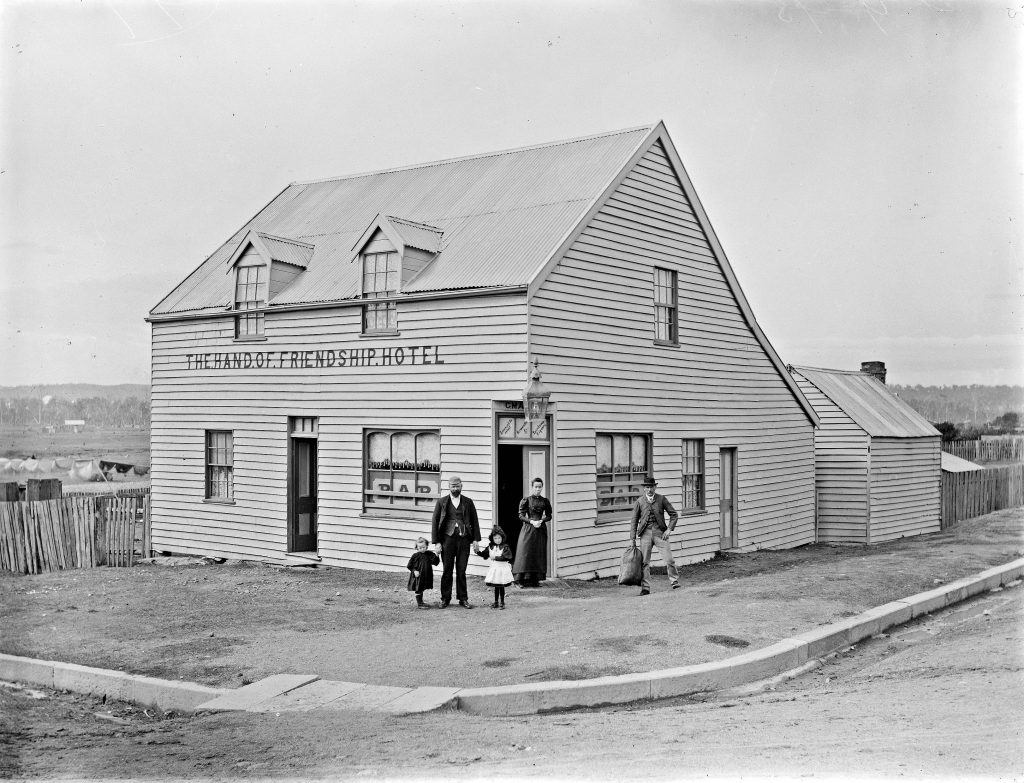
The name of the publican “G. Masters” can be partially seen in a sign above the door, behind the lamp.
Snowball photographed the hotel again in 1903, with a larger group of people out the front.

The diagonal writing in the three panels below the name says:
Licensed to retail | Fermented l(iquors) | Spirituous liquors
The publican at this time was Phillip James Byrne, having acquired the license from Edmund Butterworth three months earlier in February 1903. Note in the sign above the door there is a faint H at the end, which is probably the remnants of the name of the previous licensee.
In June 1903, just a month after Snowball’s photograph was taken, the application of Phillip James Byrne for a renewal of the license was objected to on on the grounds that “the accommodation was inadequate, and the place in an insanitary condition.” Despite the objection the renewal was granted for another year.
In 1905, with further deterioration, the police opposed the renewal of the hotel’s licence “on the ground that the building was in bad condition, owing to the white ants.” It survived that objection, but only for another year. Plans to demolish the building and erect a new hotel came to nothing, and in 1906 John Canning, the last publican to stand behind the bar of the Hand of Friendship Hotel, relinquished his licence.
The building stood idle for some time before it was sold, when it gained a new life as a second-hand goods shop. The weathering of the years however was relentless. In 1933 the building was finally demolished.
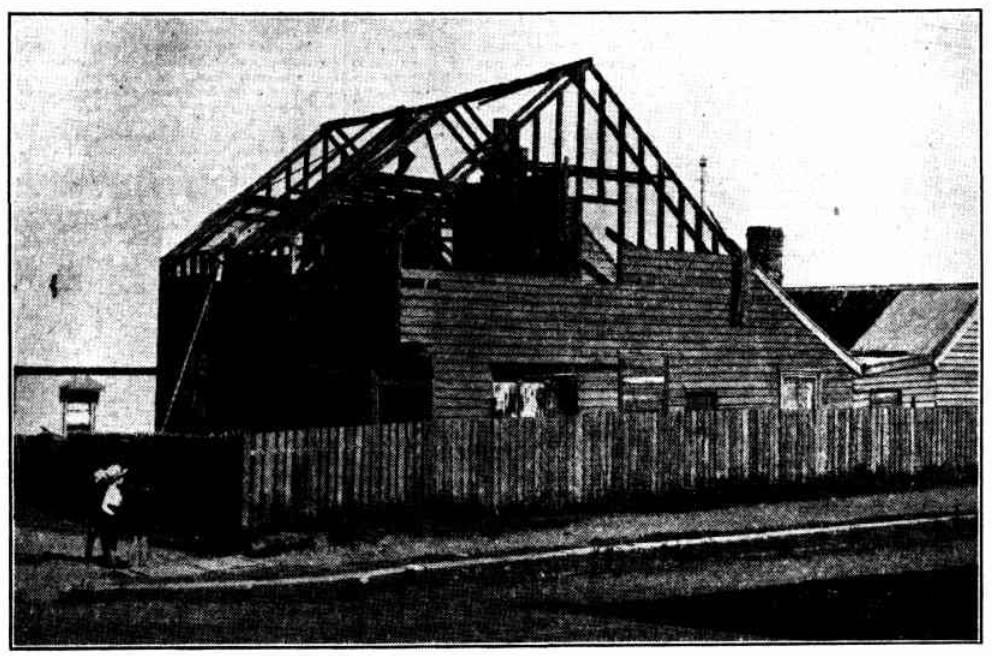

Location
An 1877 map relating to the proposed site for New Lambton public school shows the Hand of Friendship Hotel on the south-east corner of Russell Rd and Regent St.


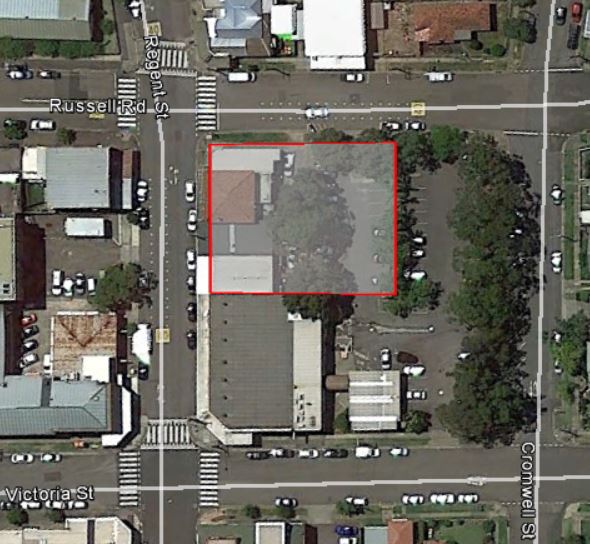
Centenary Hall
In 1906 the hotel ceased to trade, and in January 1907, the owners of the building, Tooth and Co., put the property up for sale. The sale included the land, hotel building, and the Centenary Hall adjacent to the hotel and fronting Russell Rd. The land was described as having frontage of 133ft 4in to Russell St, and 98ft 3in to Regent St.
The Centenary Hall was purchased by the New Lambton Mechanics’ Institute in 1908, and then dismantled and re-erected on the institute’s block on the corner of Regent St and Alma Lane in 1909.
Licensees
The following is a list of licensees as gleaned from various mentions in newspaper articles over the years. Some of the dates are known with certainty, as there is a report of the license being transferred from one person to another. For some licensees I have had to make an informed estimate based on the first and last reported association of the licensee with the hotel.
- Benjamin Lunn (15 September 1869 to November 1878)
- Jane Lunn (November 1878 to March 1884)
- James Lunn (May 1884 to 1886)
- John Williams (1887 to 1888)
- John (Jack) Hall (June 1888)
- Thomas (Tom) Durham (June 1888 to November 1889)
- John (Jack) Thomas (November 1889 to 1892)
- George Masters (1893 to 1895)
- Joseph (Joe) Garratt (1896 to 1899)
- Edmund (Ted) Butterworth (1900 to Feb 1903)
- Phillip James Byrne (Feb 1903 to 1904)
- John (Jack) Canning (1904 to October 1906)
- George Bertram Bowser (October 1906 to November 1906)
The 1933 article on the demolition of the building states that “Ben Bradley (afterwards an alderman in the New Lambton Council)” was also a licensee, but I can find no independent evidence for this. Benjamin Bradley did have a publican’s license at one stage, but it was for the Lake Macquarie Hotel in Teralba.
The article also states that Jack Canning “was the last to stand behind the bar of the old hotel”. Although this is true, he wasn’t the last licensee. George Bertram Bowser was the final licensee, for just under a month in October/November 1906. The report on the cancellation of his licence in November 1906 however, makes it clear that the building remained unoccupied during his short tenure as publican.
Newspaper articles
| Article Date Event Date | Notes |
|---|---|
| 16 Sep 1869 15 Sep 1869 | A publican's license granted to Mr. Benjamin Lunn, of the Hand of Friendship, New Lambton. |
| 16 Sep 1869 | A general article describing the beginnings of New Lambton, that notes that the Hand of Friendship Hotel is the second hotel in the township. "Both these houses afford abundant accommodation for the requirements of a colliery township." |
| 18 Sep 1869 18 Sep 1869 | Advertisement for the opening of the Hand of Friendship Hotel, New Lambton. |
| 29 Nov 1878 27 Nov 1878 | Death of Mr. Benjamin Lunn, landlord of the Hand of Friendship Hotel, New Lambton. |
| 5 Apr 1884 28 Mar 1884 | Death of Jane Lunn, Hand of Friendship Hotel. |
| 24 May 1884 21 May 1884 | "The license of the Hand of Friendship Hotel, New Lambton, was transferred from the executors in the estate of the late Mrs. Jane Lunn to James Lunn." |
| 17 Dec 1886 | Reference in a court hearing to "James Lunn, hotelkeeper, at New Lambton". Although the hotel is not named, it is presumed that it the Hand of Friendship hotel. |
| 23 Mar 1887 | "An inquest was held at New Lambton yesterday, at Mr. John William's Hand of Friendship Hotel." |
| 14 Mar 1888 | At a court hearing where he was a witness, John Williams is described as the "late licensee of the Hand of Friendship Hotel, New Lambton." |
| 30 May 1888 | "FOR SALE, the Lease, License, and Good will of the HAND OF FRIENDSHIP HOTEL, New Lambton, now doing a good business." |
| 7 Jun 1888 | "An application was put in for the transfer of the license of the Hand of Friendship Hotel, New Lambton, from John Hall to Thomas Durham.--Granted." |
| 8 Jun 1889 | "FOR SALE, Lease, License, Furniture, and Goodwill of the HAND OF FRIENDSHIP HOTEL, New Lambton. Apply to THOMAS DURHAM, on the premises." |
| 14 Nov 1889 | "The license of the Hand of Friendship Hotel, New Lambton, was transferred from Thomas Durham to John Thomas" |
| 24 Jun 1892 | License renewal to "John Thomas, Hand of Friendship, New Lambton". |
| 25 Mar 1893 | Charge of Sunday trading against "George Masters, of the Hand of Friendship Hotel, New Lambton" was withdrawn. |
| 13 Nov 1894 12 Nov 1894 | The roof of a stable in the course of erection at the Hand of Friendship Hotel is blown off by a strong gust of wind. The building then collapsed and three children are injured, including the six year old daughter of the publican, George Masters, who had her leg badly fractured below the knee. |
| 26 Jun 1896 | Renewal of license to "Joseph Garrett, Hand of Friendship, New Lambton". |
| 27 Mar 1899 | At a performance by the Fire Brigades' Band, "ample seating accommodation" was provided by "Mr. Joseph Garratt, of the Hand of Friendship Hotel." |
| 21 Jul 1900 | Advertisement. "FREE Public Dance, Monday Night, Butterworth's Centenary. Hall, New Lambton. Noble and Gaggetta, Musicians." The Centenary Hall was part of the Hand of Friendship Hotel site. |
| 21 Aug 1902 | "Mr. G. C. Martin, district coroner, held a magisterial inquiry at Butterworth's Hand of Friendship Hotel, New Lambton, yesterday morning." |
| 14 Feb 1903 | "Mr. Scott, S.M., granted a transfer of the license of the Hand of Friendship Hotel, New Lambton, from E. Butterworth to P. J. Byrne." |
| 19 Jun 1903 | "The application of Phillip James Byrne for a renewal of the license of the Hand of Friendship Hotel, New Lambton, was objected to on a report, furnished by Sergeant G. Salter, to the effect that the accommodation was inadequate, and the place in an insanitary condition." |
| 18 Nov 1903 | For Sale: "HOTEL, New Lambton, Tooth's Beer, long lease, good trade, low rent, cheap. Byrne, Hand of Friendship." |
| 16 Sep 1904 | Bazaar in aid of New Lambton Mechanics' Institute to be held in "Canning's Centenary Hall." |
| 23 Jun 1905 | "John Canning, Hand of Friendship Hotel, New Lambton, applied for renewal of license. The police opposed the application on the ground that the building was in a bad condition, owing to the white ants. Mr. T. A. Braye (Messrs. Braye and Cohen) appeared for the applicant and said that plans had been prepared for a new building, which would be erected. Temporary improvements would also be made. Michael Joseph Moroney, representing the owners, Tooth and Co., confirmed this statement, and the renewal was granted." |
| 19 Jun 1906 | Plans to build a new hotel on the site of the Hand of Friendship Hotel … "the firm of Tooth and Co. contemplate erecting a large hotel on the present site of their hotel property, situated at the corner of Regent-street and Russell-road." |
| 12 Oct 1906 | LICENSING COURT. The following transfers were approved :- From John Canning to George Bertram Bowser, Hand of Friendship Hotel, New Lambton, and from Thomas Mclntosh to John Canning, Sportsman's Arms, New Lambton. |
| 9 Nov 1906 | "In the matter of the Hand of Friendship Hotel, New Lambton, Sub-Inspector Goulder applied for cancellation of the license. The hotel changed hands on October 11, and since that date had remained unoccupied. The license, which was held by W. Bowser, was formally cancelled." |
| 23 Jan 1907 | For sale - "THAT PROPERTY KNOWN AS THE Hand of Friendship Hotel, Fronting Regent-street, and THE CENTENARY HALL, Fronting Russell-street." |
| 2 Nov 1933 | Report on the demolition of the Hand of Friendship Hotel building. |
Sportsman’s Arms Hotel (1) (1870-1903)
In a 16 September1869 article on the rapid progress of New Lambton, the Newcastle Chronicle noted there were two hotels already and that “a third public-house is in course of erection, and the proprietor, Mr.Jones [sic], expects a license for it shortly after it is finished.” Just a few months later, on 22 January 1870, Nicholas Johns announced by way of advertisement the opening of the Sportsman’s Arms hotel.

The hotel was located on the north-west corner of Regent St and Portland Pl.

In 1895, John Thomas purchased from the New Lambton Land and Coal Company, lots 6 and 7 of Section H, where the hotel building was located. Subsequently on 6 May 1899, Marshalls Paddington Brewery Limited purchased the hotel land and building.

Three years later in July 1902, Marshall’s Brewery commenced plans to construct a new hotel building in Hobart Rd, with the intention of transferring the license of the Sportsman’s Arms to the new premises and closing the original hotel in Regent St. The transfer of the licence to the new location occurred a year later in July 1903. William Thompson, the last licensee at the old location, continued on as licensee at the new premises.
The old Sportsman’s Arms Hotel in Regent-street, which is one of the oldest buildings in the municipality, and in the early days was considered to be among the best of its class, is now closed, the license having been transferred to the new building recently erected by the Marshall’s Brewery Company in Hobart-road.
Newcastle Morning Herald and Miners’ Advocate, 4 Jul 1903.
The old hotel building was occupied as a private dwelling for about two years, but after being vacant for several months a fire destroyed the building in June 1905. There are no known photographs of the original hotel building.
The land was then owned by a number of different people in the next 17 years, and then on 20 November 1922 the Methodist Church purchased the land to erect a church building

The New Lambton Uniting Church occupies the site today.

Licensees
- Nicholas Johns [Jones] (January 1870 to March 1871)
- Abraham Butterworth (March 1871 to June 1875)
- George Thomas (July 1875 to June 1879)
- Robert Morgan (June 1879 to February 1883)
- James Peattie (March 1883 to October 1883)
- James Williams (October 1883 to c. June 1884)
- Phillip J [G] Thorley (c. July 1884 to July 1884)
- Thomas Pringle (c. September 1884 to c. October 1887)
- Abraham Cowell (c. October 1887 to August 1893)
- John Thomas (August 1893 to c. March 1899)
- William Dorrity [Dorritty] (c. May 1899 to c. March 1902)
- William Thompson (c. July 1902 to June 1903 at Regent St, then continued as licensee at new premises in Hobart Rd)
Sportsman’s Arms Hotel (2) (1903-1987)
On 26 March 1902, William Masefield Bostock advertised …
… that I desire to obtain and will at the next Quarterly Licensing Court to be holden at Newcastle on the Third Day of April Next apply for a Certificate authorising the issue of a Conditional Publican’s License for premises proposed to be erected and situated at the corner of Alma-road and Lambton-road, and to be known by the sign of “Sportsman’s Arms,” and containing eleven rooms, exclusive of those required for the use of the family.
Newcastle Morning Herald and Miners’ Advocate, 26 March 1902.
At the licensing court held on 14 April 1902, Bostock stated …
… that he was an agent for Marshall’s Brewery Company, who had an hotel known as the Sportsman’s Arms Hotel, New Lambton, and he proposed to remove the license of that house to that for which he was applying for a conditional license. He had a guarantee, which he produced, from his company to close the Sportsman’s Arms should the new license be grant ed. The site of the proposed hotel was at the intersection of Alma-road and Lambton-road, opposite Roberts’ store. He did not own the land, but had taken certain steps to procure it.
Newcastle Morning Herald and Miners’ Advocate, 15 April 1902.
After hearing arguments the Bench refused the application “on the ground that the requirements of the place did not justify a license.”
The refused license did not deter the applicants. Foregoing their plans for a hotel on the corner of Alma and Lambton Rd, Marshall’s Brewery purchased lot 1356 on the corner of Hobart and Rugby Roads from William Thompson, and at a hearing on 4 July 1902 resubmitted their application for a conditional license. The police lodged an objection “on the ground that the requirements of the place did not justify the issue of a license”, the bench deferred their decision to a later hearing. After visiting the New Lambton and inspecting the existing hotels, and the site of proposed new hotel, the licensing bench granted the conditional license on 15 July 1902.
In April 1903 the newspaper reported that …
A large brick hotel is now being erected for Mr. Thomson overlooking the reserve, close to the tram terminus. The roof which is of red tiles, is now completed, and the contractor, Mr. Viggers. is busy finishing the interior to the designs of Mr. Henderson, architect.
Newcastle Morning Herald and Miners’ Advocate, 17 April 1903.
The new hotel opened for business just a few months later in July 1903.
The old Sportsman’s Arms Hotel in Regent-street, which is one of the oldest buildings in the municipality, and in the early days was considered to be among the best of its class, is now closed, the license having been transferred to the new building recently erected by the Marshall’s Brewery Company in Hobart-road.
Newcastle Morning Herald and Miners’ Advocate, 4 July 1903



Photos from the from the Sportsman’s Arms Hotel ‘yellow cards’ in the ANU Open Research Repository shows that the exterior of the hotel remained largely unchanged during its lifetime.


The Wests Leagues Club purchased the Sportsman’s Arms hotel in 1987 and demolished it to enable an extension of their club premises.

Commonwealth Hall
William Thompson, on the same day that he had purchased the land for the new Sportsman’s Arms Hotel, also bought another block of land on Hobart Rd. (Lot 1349,Vol-Fol 1750-42.) In 1903 Thompson erected a hall on this land, naming it the Commonwealth Hall, which was formally opened at a Fire Brigade social on 16 October 1903.
The Mayor (Alderman Errington), on behalf of the proprietors, declared the hall open. In doing so he explained that the building was to be known as the Commonwealth Hall. Alderman Errington referred to the rapid progress New Lambton was making, and said the building just completed, besides being an ornament, would be a valuable addition to the town.
Newcastle Morning Herald and Miners’ Advocate, 19 October 1903.



The Commonwealth Hall was used for many events in New Lambton in the next decade, socials, fundraisers, community meetings, political meetings, concerts, etc.
In 1912 the licensee of the Belmont Hotel, John Sperring, purchased the hall and in July 1912 advertised that …
TENDERS are invited for taking down the Commonwealth Hall, situated at New Lambton, Removing, and Erecting at Belmont.
Newcastle Morning Herald and Miners’ Advocate, 6 July 1912.
A newspaper article in December 1913 spruiking the pleasures of Belmont noted that
The town possesses accommodation in the way of halls for entertainment, and within the past year Mr. Sperring, licensee of the Belmont Hotel, has erected a large hall adjoining the hotel grounds. The building is 70 feet long by 30 feet wide, and will seat comfortably about 500 persons. It has a large stage capable of mounting big acts. and the floor is well adapted for dancing. The building was previously the Commonwealth Hall at New Lambton, which Mr. Sperring purchased, and had re-erected, strengthened, and generally improved in its interior decorations. The hall is frequently used by moonlight excursion parties.
Newcastle Morning Herald and Miners’ Advocate, 25 December 1913.
Note that Sperring’s Belmont Hotel is not the modern day Belmont Hotel in Hitchcock Avenue. There was an earlier Belmont Hotel on the west side of the Pacific Highway, opposite George Street. In the photograph below from the Lake Macquarie History site, the building to the left of the hotel is probably the re-erected Commonwealth Hall.

Licensees
Some details of licensees after 1919 are taken from the Sportsman’s Arms Hotel ‘yellow cards’ in the ANU Open Research Repository.
- William M. Bostock (July 1902 to June 1903, conditional licence while new hotel constructed)
- William Thompson (July 1903 to c. January 1905)
- James White (c. March 1905 to September 1905)
- Thomas McIntosh (November 1905 to October 1906)
- John Canning (October 1906 to 15 November 1907)
- David Russell (15 November 1907 to 26 November 1907)
- this is possibly erroneous, as only two weeks later another report states that the licence was transferred from John Canning to William Smith
- William Smith (26 November 1907 to death of Smith on 28 January 1908)
- Thomas Griffiths (January 1908 to March 1909)
- William Dent (April 1909 to April 1914)
- John Joseph Healey (May 1914 to January 1915)
- Richard Edward Goddard (February 1915 to March 1916)
- John Joseph Healey (April 1916 to August 1918)
- Joseph Patrick Walsh (August 1918 to c. November 1919)
- Edgar Condie [Condy] (c. November 1919 to July 1920)
- Arthur Haviland (July 1920 to July 1920)
- Thomas Wallington (August 1920 to October 1921)
- Garfield Theodore Du Rieu (October 1921 to February 1922)
- Robert Meek Hopes (March 1922 to October 1923)
- Mrs Ellen Chappell (October 1923 to April 1935)
- William Dominic Ruggeri (April 1935 to death of Ruggeri on 18 February 1950)
- Mrs Catherine Anne Ruggeri (April 1950 to November 1957)
- William Henry Murphy (November 1957 to July 1959)
- William Smoker Boyling (July 1959 to April 1963)
- Horace William Box (April 1963 to March 1965)
- William Edward Compton (March 1965 to December 1978)
- Roy Raymond Beverly (December 1978 to ????)
Nil Desperandum Hotel / Duckenfield Hotel (1876-1880)
The Nil Desperandum was New Lambton’s shortest-lived hotel, operating for just four years from July 1876 to June 1880. There are no known photographs of the hotel. The first mention of the hotel in the newspaper was a short notice on 15 July 1876 advising that …
Mr. Edgar Ashley [sic] has opened his new hotel under the name of Nil Desperandum.
Newcastle Morning Herald and Miners’ Advocate, 15 July 1876.
and on the same day an advertisement seeking a servant.
WANTED, a Female General Servant, one accustomed to a Public House. Apply Mrs. E. ASHBY, Nil Desperandum Hotel, New Lambton
Newcastle Morning Herald and Miners’ Advocate, 15 July 1876.
The Government Gazette of publican licenses for the year commencing 1 July 1876 lists Edgar William Ashby as the licensee of the Nil Desperandum Hotel, Griffen-street, New Lambton. Griffen Street (or more correctly Griffin) was the original name for what later became Victoria Street. The hotel was located on the south-west corner of Victoria and Cromwell Streets, on land leased by Thomas Sneddon (sometimes spelled Sneddan) from the New Lambton Coal Company.

In 1878 Edgar Ashby constructed a music hall on land adjoining the hotel, and formally opened the hall on 21 May 1878.
Mr. Ashby, landlord of the Nil Desperandum, has, at a considerable cost, erected a fine hall adjoining his hotel. The building is 36 feet by 24 feet, and is to be fitted up for all kinds of public entertainments and meetings. This is a want which has long been felt by the people of New Lambton, and especially the miners, who have never had a proper place to meet in. The hall is to be opened on Tuesday, the 21st inst., by a grand ball and supper.
Newcastle Morning Herald and Miners’ Advocate, 14 May 1878.
We are left to wonder about the details, but something was awry in the Ashby family. Edgar Ashby place the following advertisement in July 1879.
I EDGAR ASHBY, of New Lambton, will not be responsible for any debts contracted by my wife, JANE ASHBY, from this date.
Newcastle Morning Herald and Miners’ Advocate, 25 July 1879.
The following month the license of the hotel changed hands, with an advertisement on 21 August 1879 announcing that …
HENRY DOHERTY, (LATE OF THE RACE HORSE INN, LAMBTON), HAVING TAKEN THE NIL DESPERANDUM HOTEL, New Lambton, hopes, by keeping the BEST BRANDS of Wines, Spirits, and Ales, to merit a fair share of the public patronage.
Newcastle Morning Herald and Miners’ Advocate, 21 August 1879.
The new licensee also took over the operation of the adjoining hall, and there a few references to “Doherty’s Hall” in 1878 and 1879. On 11 June 1880, Henry Doherty advertised for sale “the Lease, License, Furniture, and Stock” of his hotel in New Lambton. There appears to have been no takers on this offer from the licensee (Henry Doherty), and 17 days later the lessee (Thomas Snedden) was advertising the hotel for rent.
TO LET, the Nil Desperandum Hotel, New Lambton, with Concert Hall, and every convenience. Rent moderate. Apply to THOMAS SNEDDEN, Storekeeper, New Lambton.
Newcastle Morning Herald and Miners’ Advocate, 28 June 1880.
This advertisement also seems to have been met with a stony silence, for there is no further mention of the hotel as a going concern. The hotel building was demolished in 1937 and the music hall demolished in 1949.
In Cromwell-street, New Lambton Mr. S. Bagnall spent the week completing the demolition of a building. Casual passers-by might have thought it was just a garage that had served its. day, but old stagers knew it was more than that. It was one of the district’s oldest private halls. There was scarcely room to swing a hip, if you gauged by modern standards, for the wooden hall was only 40 by 26 feet. The hall was part of the Nil Desperandum Inn, which stood on the corner of Cromwell and Victoria Streets. It was run by the innkeeper, Mr. Tom Sneddon, sen., a native of Dalkeith, Scotland.
At the back of both buildings the innkeeper planted a small forest of camellia trees. About 100 trees remain, 70 to 80 years old, still blossoming and supplying city florists.
Somewhere along the years the inn was closed and became a private residence for Mr. and Mrs. Sneddon and their children-two boys and two girls. The bar was partitioned off and let as a doctor’s surgery. The dance hall was also closed. It was used to store the odds and ends that in houses with attics are usually hidden in the ceilings. In 1937 the inn was demolished, but the hall remained. Soon, all that will remain of the Nil Desperandum and its hall will be the camellia forest and the inn’s 20ft. well.
Newcastle Morning Herald and Miners’ Advocate, 1 October 1949.

A 1938 aerial photo of New Lambton shows an empty space on the corner where the hotel building was demolished the year before. The hall and the camellia garden at the rear is still visible.


Duckenfield Hotel
Between 1877 and 1880 there are a handful of references to a “Duckenfield Hotel” in New Lambton. While there is no definitive proof, the available evidence strongly suggests that this was the Nil Desperandum hotel trading with a different name.
- All the references to the Duckenfield Hotel (1877 to 1880) are in the same range of years for the Nil Desperandum Hotel (1876 to 1880)
- There are no references where both hotels are mentioned together, which would conclusively prove they were different hotels. Crucially, the Government Gazette licensee lists in this period only ever contain one of the two names, and always on the same street, with the same licensee.
- In August 1879 Henry Doherty advertised his taking over of the Nil Desperandum Hotel, but just four months later in December 1879 there is a reference to “Doherty’s Duckenfield Hotel”.
- In June 1880 there are two references to a hotel in New Lambton being up for lease – Doherty’s Duckenfield Hotel on 11 June 1880, and the Nil Desperandum Hotel on 28 June 1880. Neither hotel is heard of again. It seems highly unlikely that two different hotels on the same street would disappear from the records in the same month.
Licensees
- Edgar William Ashby (July 1876 to August 1879)
- Henry Doherty (August 1879 to June 1880)
Duke of Wellington Hotel (1876-present)
The Duke of Wellington hotel was first introduced to the public in a brief article of New Lambton news on 15 July 1876 that mentions that …
… another [new hotel] will shortly be opened by Mr. D.Jones.
The Government Gazette of publicans’ licenses issued for the year commencing 1 July 1876 has an entry for “David Jones, Duke of Wellington Hotel, Horsefield-street, New Lambton.” Horsfield Street was the original name for Regent Street, and the hotel was located at its present site on the corner of Regent Street and Portland Place, on Lot 6 of Section 6, which was leased by the New Lambton Coal Company to Abraham Butterworth. Abraham Butterworth was the second licensee of the hotel, for a brief period from April 1878 to February 1879.

The first photograph of the Duke of Wellington Hotel dates from the time of the eighth licensee, Joseph Garratt (1887 to 1895). The photo shows a very basic weatherboard building, as were all the early New Lambton hotels. This was because up until about 1886 the New Lambton Coal Company did not sell any of their land for housing or businesses, but only provided 14 year leases. Naturally, residents and businessmen were reluctant to build any substantial structures on land they did not own or control in the long term. As a consequence, in contrast to neighbouring Lambton, no substantial building in New Lambton from the 19th century has survived to the present day.

After the New Lambton Coal Company started selling land, Abraham Butterworth purchased the Duke of Wellington building and land in 1891. (Vol-Fol 1006-20)
In 1898 George Burt made improvements and additions to the hotel.
Among the number of new buildings lately erected in this municipality are the improvements and additions made at Burt’s Duke of Wellington Hotel. Particular attention has been given to make the alterations roomy, with plenty of ventilation, and a good height, the bar and parlours being very noticeable in this respect. A staircase 3ft wide leads to the hall, 16 x 32, which is intended for a lodge or supper room.
Newcastle Morning Herald and Miners’ Advocate, 6 June 1898.
In 1919 Abraham Butterworth sold the property to the Castlemaine Brewery and Wood Brothers. (Vol-Fol 1006-20, p2). In August 1921, at a Licensing Court hearing …
Permission was given to Paul Turnbull, licensee of the Duke of Wellington Hotel, New Lambton, to erect a new brick building.
The Newcastle Sun, 16 August 1921.
… and the following week …
Paul Turnbull was given permission to carry on business in temporary premises during the reconstruction of the Duke of Wellington Hotel, New Lambton.
The Newcastle Sun, 23 August 1921.
The fittings, fixtures and timbers of the old hotel building were put up for auction on Saturday 10 September 1921. Strangely for such a major project, the newspaper contains no reports on the demolition of the old building, or the construction and re-opening of the new building. A photo from 1924 shows the building with clean sharp brickwork and the year “A.D. 1921” prominently displayed on the corner facade.



In September 1954, Pitt & Pitt architects called for “tenders for extensive alterations and additions, to Duke of Wellington Hotel for Tooth & Co.” Presumably these were the alterations that ‘modernised’ the exterior, and arguably denuded the building of its 1920s architectural charm.




Licensees
Some details of licensees after 1919 are taken from the Duke of Wellington Hotel ‘yellow cards’ in the ANU Open Research Repository.
- David Jones (July 1876 to April 1878)
- Abraham Butterworth (April 1878 to February 1879)
- Thomas Pringle (February 1879 to June 1883)
- Thomas Durham (July 1883 to December 1883)
- John Kelly (January 1884 to at least July 1884)
- George Thomas (c. July 1885 to c. August 1885)
- Thomas Durham (c. September 1885 to c. March 1887)
- Joseph Garratt [Garrett] (c. July 1887 to c. June 1895)
- George Burt (c. June 1895 to August 1898)
- Dorothy Garner (August 1898 to c. November 1898)
- Edmund [Edward] Butterworth (c. June 1899 to c. January 1900)
- John Atkinson (c. January 1900 to April 1902)
- Thomas Thompson (April 1902 to February 1903)
- Edward Cambourn (February 1903 to c. Dec 1907)
- Hugh Buchanan (c. May 1908)
- Patrick Slavin (c. June 1909)
- Catherine Slavin (December 1913, on death of Patrick Slavin, to c. January 1913)
- Robert Allen Frew (c. January 1914 to June 1915)
- Paul Turnbull (July 1915 to January 1925)
- Sylvester Patrick Keely [Kelly] (1 February 1925 to 18 January 1926)
- Alex Campbell Smith (19 January 1926 to 17 May 1926)
- Albert P. Hillier (18 May 1926 to 28 March 1927)
- James Richard Dixon (29 March 1927 to 26 March 1928)
- Horace Dee Magner [Wagner] (27 March 1928 to 27 August 1928)
- George E. Duckworth (28 August 1928 to 22 December 1932)
- John David Evans (23 December 1932 to 8 October 1945)
- Thomas Rawle (9 October 1945 to 27 October 1947)
- Beatrice Millie Groves (28 October 1947 to 27 November 1947)
- Frederick Hector (28 November 1947 to 21 November 1960)
- Kevin Ray Matthews (22 November 1960 to 25 May 1964)
- Joan Audrey Muriel Smith (26 May 1964 to 13 December 1967)
- William George Morgan (14 December 1967 to 19 April 1972)
- Robert Arthur Monnox (20 April 1972 to 28 April 1976)
- Edward Joseph Chapman (29 April 1976 to 15 June 1977)
- Charles Alexander Robertshaw (16 June 1977 to 3 May 1978)
- Wayne Maxwell Balcomb (4 May 1978 to 17 October 1979)
- Noel Samuel Smith (18 October 1979 to ????)
Misnomers
For a couple of years, in 1897 and in 1898, the Government Gazette for publican licensees lists the hotel as the “Duke of Edinborough”. This is almost certainly an error due to a confusion between the two dukes – a confusion that often recurred. For example in March 1928 when referring to the transfer of licence from Richard Dixon to Horace Dee Magner, the Newcastle Morning Herald correctly reported the name as “Duke of Wellington” while the Newcastle Sun reported the name “Duke of Edinburgh”.
Sunnyside Hotel (1884-present)
The Sunnyside Tavern is located in Broadmeadow Rd, Broadmeadow. I have included it in this page of New Lambton Hotels, as this location fell within the borders of the New Lambton Municipal Council which operated from 1889 to 1938.
Specifying the location of the Sunnyside has always been problematic, as the names and boundaries of suburbs in this area have changed over time. Here are some examples of the different locality names the hotel has been placed in over the years …
- Broad Meadows (1884)
- Broad Meadow (1885)
- Broadmeadow (1891)
- Georgetown (1922)
- Hamilton North (1933)
- Newtown (1904) (Newtown was the original name of Hamilton North)
- New Lambton (1916)
- Waratah (1893 and 1919)

On 17 June 1884, Michael Fenwick of Waratah, gave notice in an advertisement of his intention to apply at the next Licensing Court for …
… the issue of a Publican’s License for premises situated at Broad Meadows Road, between Waratah and Hamilton, and to be known by the sign of “Sunnyside Inn,” containing six rooms, exclusive of those required for the use of the family.
Newcastle Morning Herald and Miners’ Advocate, 17 June 1884.
Four months later another advertisement announced …
SUNNYSIDE INN, BROAD MEADOW. MICHAEL FENWICK desires to intimate to his many friends and the public that he has OPENED the above NEW INN, and is now prepared to accommodate all who may favour him with a call.
Newcastle Morning Herald and Miners’ Advocate, 18 October 1884.
The establishment was equally referred to as the “Sunnyside Inn” and “Sunnyside Hotel” in its first 30 years. There are no known photographs of the first hotel building. In 1903 Joseph Heslop became licensee, and progressed plans for significant renovations to the hotel building.
Tenders are due on Saturday for important extensions to the Sunnyside Hotel, Broadmeadow-road, near Georgetown. It is proposed to add a floor space above at this hotel and have a colonnade. This work will involve an outlay of £500 or £600.
Newcastle Morning Herald and Miners’ Advocate, 2 July 1904.
By October the renovations were well underway.
The Sunnyside Hotel has been pulled down all but four rooms, and a brick two-storey addition erected of twelve rooms, with a colonnade in the centre and balconies on each side. The stable buildings are also to be made in keeping with the hotel, and when all is completed (by Messrs. Bates and Everett, the builders) this will be a well-appointed establishment.
Newcastle Morning Herald and Miners’ Advocate, 12 October 1904.
Judging by the shiny corrugated iron roof and crisp paintwork, Ralph Snowball photographed the hotel building not long after the renovations were completed.

Around the time of Joseph Heslop’s tenure and the renovation in 1904, use of the name “Sunnyside Inn” declined, and afterwards it was principally referred to as the “Sunnyside Hotel”.
A 1909 Water Board map shows that an extension had been made at the northern end of the building. This was possibly the stables alluded to in the October 1904 report.


In March 1921 Tooth and Co purchased the hotel, and in July 1921 “Percy George Phillips, licensee of the Sunnyside Hotel, was granted permission to make alterations and additions to his premises.” The alterations were in progress by December, and completed by April 1922 when the Newcastle Sun reported on the new hotel building.
Residents of the Newcastle district are agreeably surprised when passing through Georgetown at the view of the re-constructed Sunnyside Hotel. The old building which is true was a landmark of this locality, was entirely demolished, and in its stead has been erected a modern hotel of pleasing design. The new premises contain a commodious bar, two parlors, store room, office, public and private dining-rooms, kitchen, pantry and laundry, and the necessary lavatory; accommodation on the ground floor and on the first floor there are 14 bedrooms, sitting-room, two bathrooms, linen cupboards, and other conveniences. The outside walls are tiled up to height of the sill, and a suspended awning protects the front. The work was carried out by Mr. R. E. Waller, to the plans and under the supervision of Mr. W. L. Porter, architect, at a cost of approximately £1,500.
The Newcastle Sun, 3 April1922.




Ed Tonks on page 13 of his book “No Bar To Time” notes that the establishment was changed from a hotel license to a tavern license on 29 May 1978, and the name change to “The Sunnyside Tavern” probably occurred at that time also.

Licensees
Some details of licensees after 1919 are taken from the Sunnyside Hotel ‘yellow cards’ in the ANU Open Research Repository.
- Michael Fenwick (October 1884 to death in March 1896)
- Harriet Fenwick (April 1896 to March 1900)
- William Henry Allen (April 1900 to c. September 1900)
- Andrew Kirkaldy (1901 to November 1902)
- Bridget Lee (December 1902 to April 1903)
- Joseph Heslop (May 1903 to August 1911)
- Randolph Baldwin (August 1911 to c. September 1915)
- Robert Forbes (c. February 1916 to c.October 1917)
- June 1917 – Mrs Forbes acting as licensee while her husband is on active service
- James Frazer (c. September 1918 to May 1919)
- Percy G. Phillips (May 1919 to 18 July 1923)
- W. W. Lake (19 July 1923 to 7 August 1923)
- J. H. Sampson (8 August 1923 to 27 April 1925)
- P. Quinn (28 April 1925 to 10 October 1932)
- T. Shipley (11 October 1932 to 15 April 1934)
- Henry G. Dunne (16 April 1934 to death of Dunne on 6 December 1963)
- Walter George Farnham Dunne (27 June 1962 as agent for estate, 26 May 1963 in own right)
- Daphne Joyce Ada Dunne (21 January 1964 as agent, 2 March 1965 in own right)
- Name change by marriage, to Mrs D. J. A. Ling, on 15 August 1969
General Roberts Hotel (1903-present)
Also see my April 2023 article for The Local on the General Roberts Hotel.
In 1898 Frederick George Roberts purchased land on the corner of Lambton and Tauranga Roads.
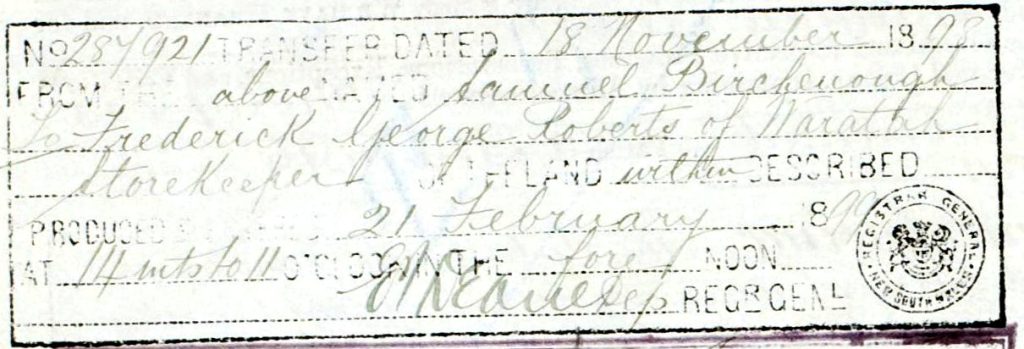
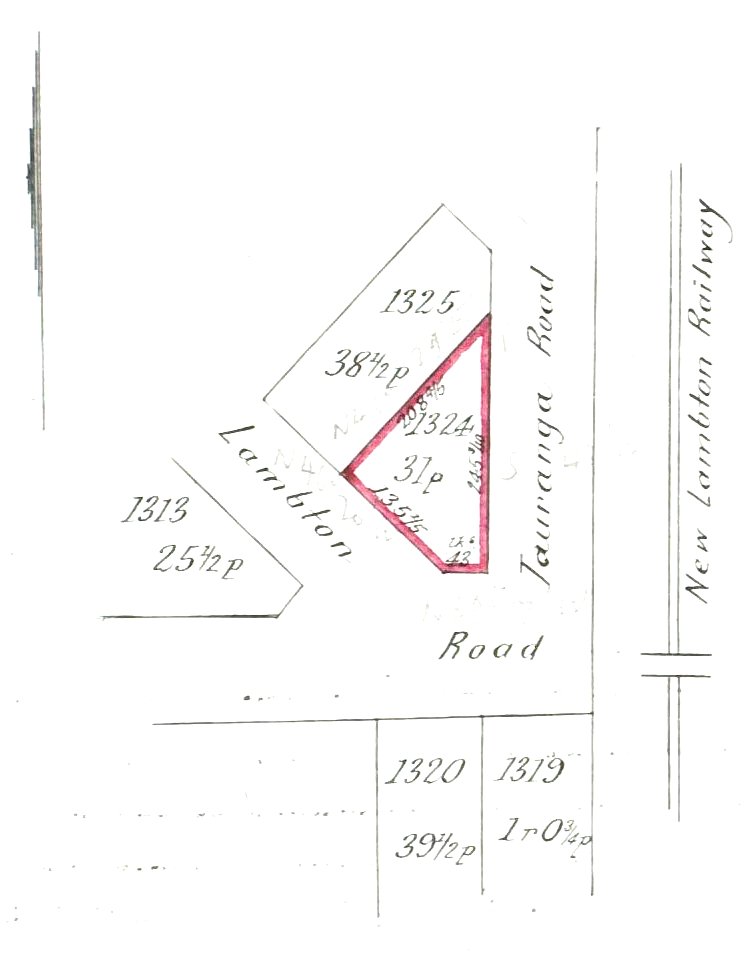
After purchasing the land, Roberts built a weatherboard store, selling groceries, draperies, ironware and clothing.
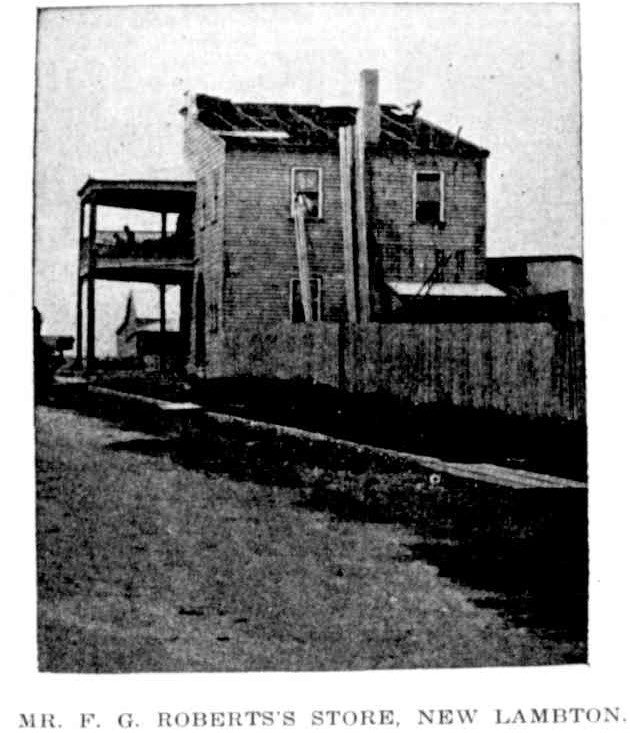
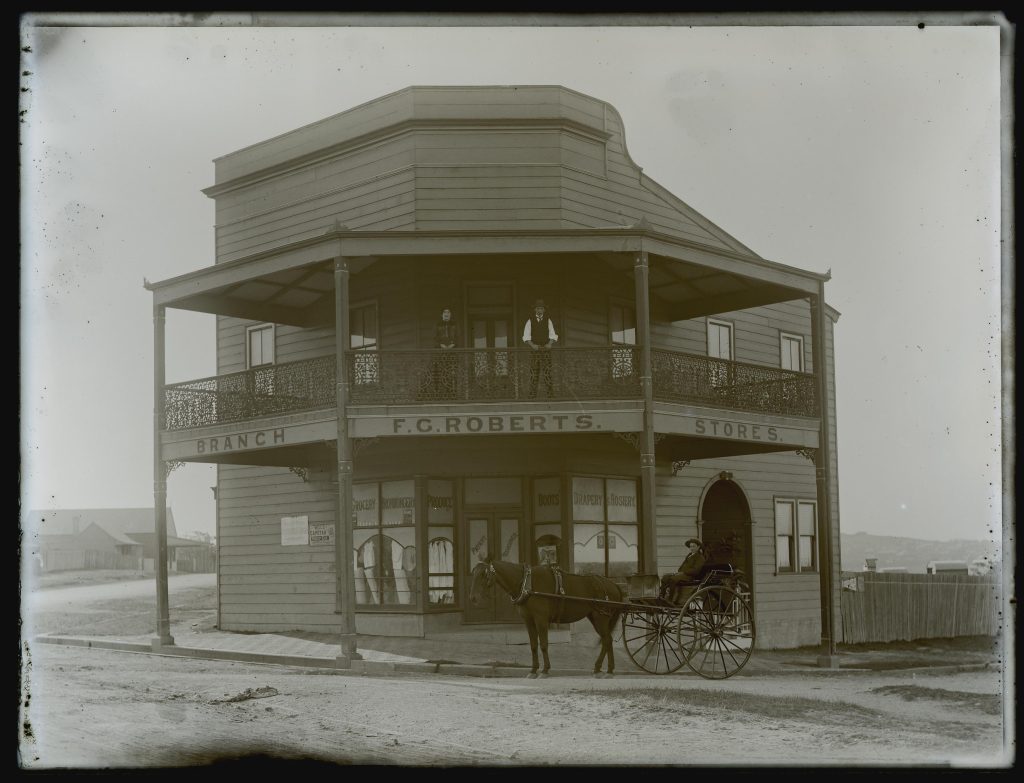
In July 1902 Roberts applied for a publican’s license to open a hotel on the site of his store. Despite police objections the licensing court granted the application, in part swayed by Roberts’ plans to erect a substantial brick hotel, in contrast to the other hotels nearby that were described at the time as “a very disappointing lot indeed”.
By September 1902, the store was demolished, and the builder William Knight was constructing a new brick hotel designed by the notable local architect Ernest George Yeomans. On 18 April 1903 Roberts announced by advertisement that his “new hotel will be opened for business today, containing 20 spacious and well ventilated rooms.” He named it the General Roberts Hotel, after Frederick Sleigh Roberts, recently commander of the British forces in the Second Boer War.
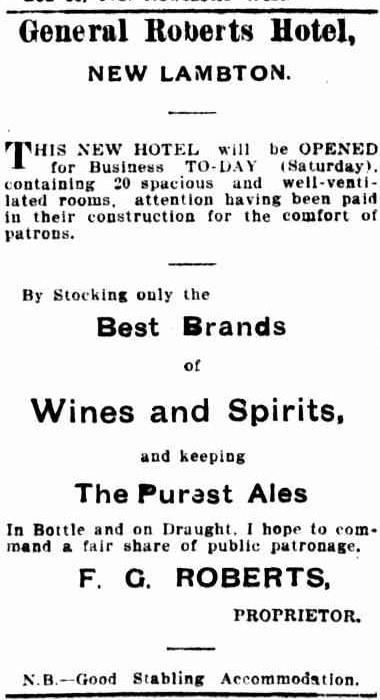
At the corner of the main road and Tauranga-street another brick hotel of 18 rooms, to be known as “The General Roberts,” has just been completed. This is built with red, pressed, tuck-pointed fronts and ornamental parapets. The fronts have those useful adjuncts, spacious colonnades. The building is tastefully finished both inside and out, and standing on a prominent site is a landmark in the municipality. Formerly on this site stood Mr. Roberts’ w.b. store, which has been demolished to make place for this hotel. The architect was Mr. E. G. Yeomans. and the builder Mr. W. Knight.
Newcastle Morning Herald and Miners’ Advocate, 17 April 1903.
Within six months of opening the hotel, F G Roberts was looking to sell the hotel business, but retain ownership of the land and buildings.

Phillip Byrne became licensee in April 1904, and Ralph Snowball photographed the hotel soon afterwards in July 1904. Looking west along Lambton Rd and Alma Rd, the photo shows the General Roberts Hotel on the right, and beside it the remnants of a cutting where the New Lambton colliery railway once ran.
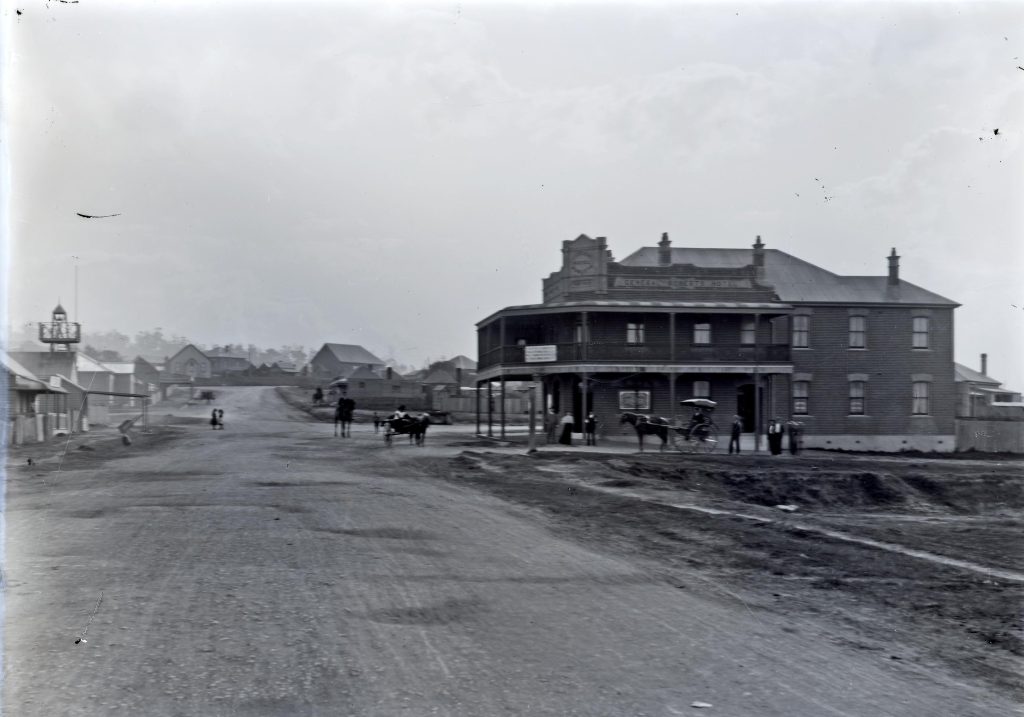
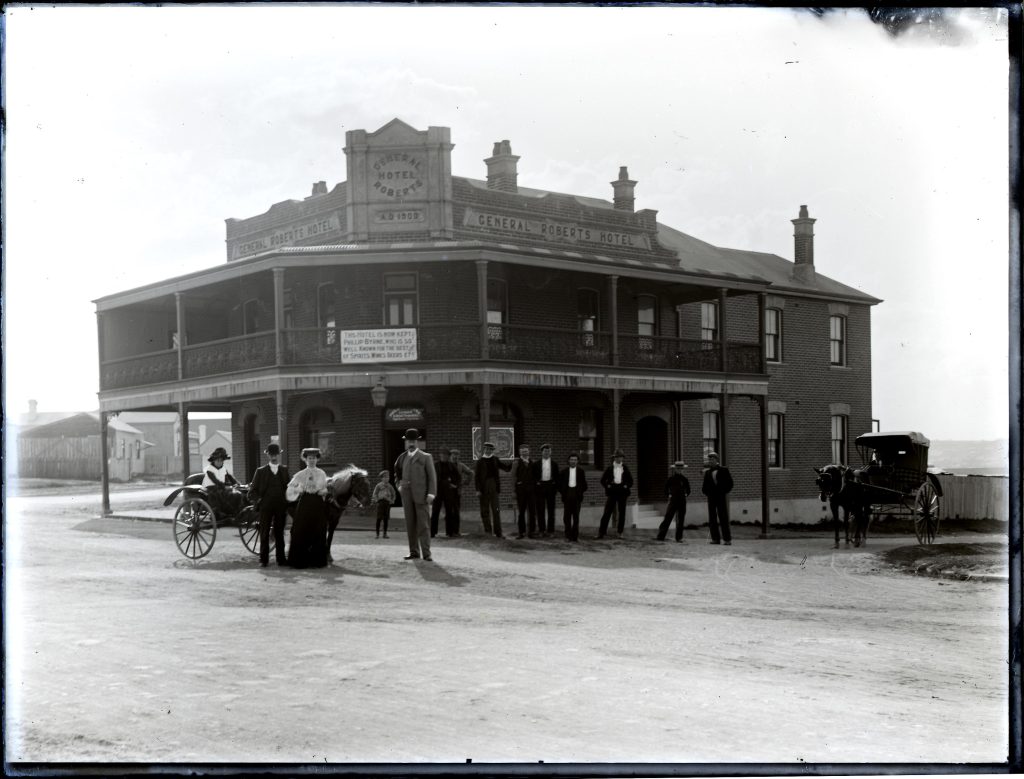
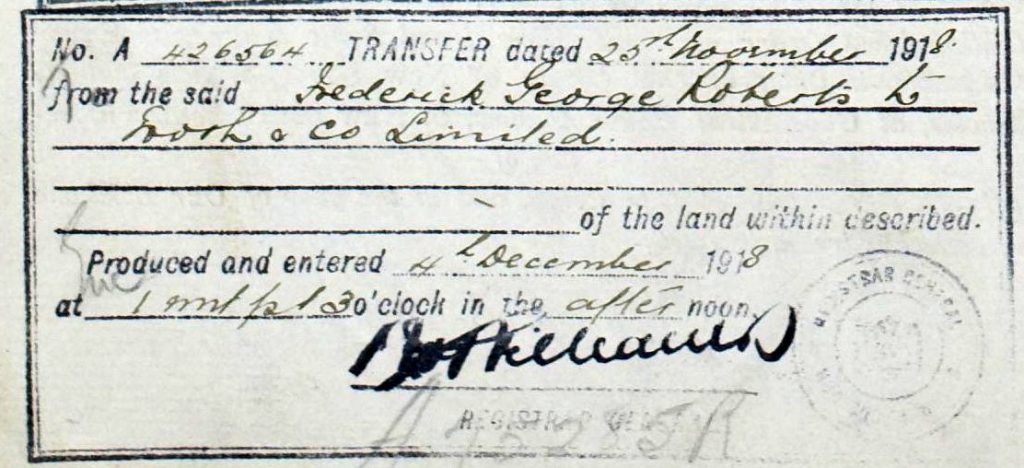



The General Roberts Hotel was rebuilt in 1957, at a cost of £65,672.

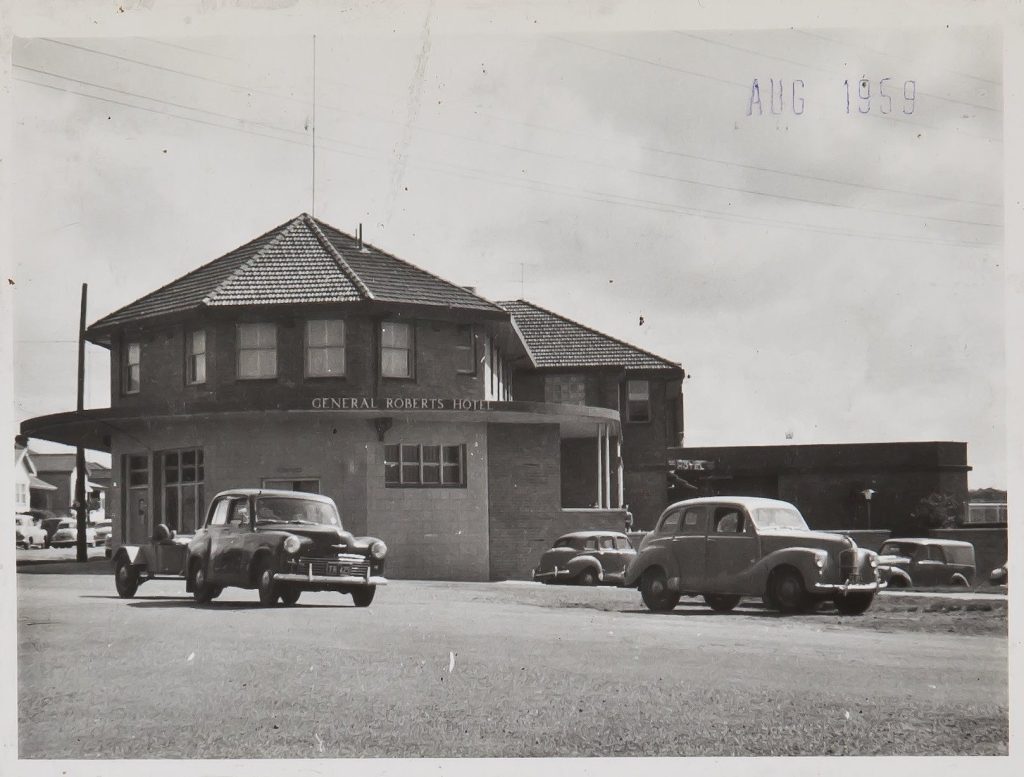
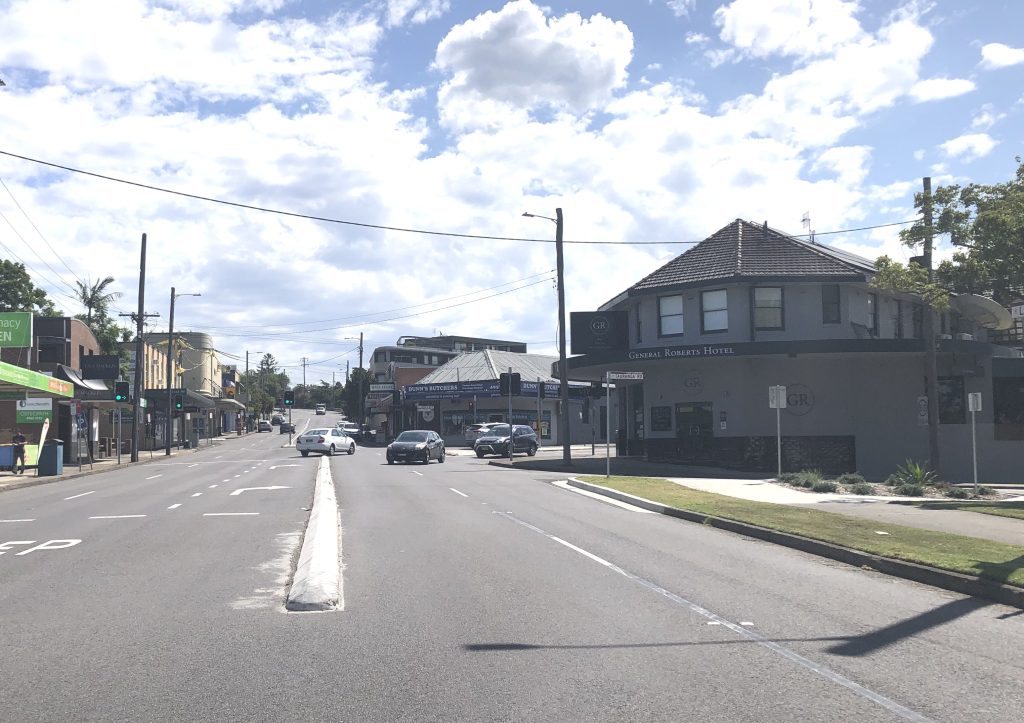
Licensees
Some details of licensees are taken from the General Roberts Hotel ‘yellow cards’ in the ANU Open Research Repository.
- Frederick George Roberts (April 1903 to April 1904)
- Phillip James Byrne (April 1904 to June 1905)
- John Keim [Kiem, Kilm, Kien, Kiern, Kierns] (June 1905 to April 1913)
- Edward Butterworth (April 1913 to April 1916)
- John Drummond (April 1916 to May 1919)
- Oliver O Woods (May 1919 to September 1919)
- Frank Burden (September 1919 to July 1927)
- George James Embleton (July 1927 to April 1928)
- Leonard P Damerell [Damerill] (April 1928 to January 1929)
- Joseph Patrick Quinn (January 1929 to November 1945)
- William Thomas Garaty (November 1945 to June 1957)
- James Robert Rose & Mary Rose (June 1957 to January 1961)
- Albert Frederick Seales (January 1961 to April 1966)
- David Alfred James Blanch & Ann Blanch (April 1966 to March 1968)
- Joseph Moody & Ellen McReadie (March 1968 to ????)
Newspaper articles
| Article Date Event Date | Notes |
|---|---|
| 2 Jan 1899 | "A large general store, and residence for Mr. Roberts is in course of erection at the corner of Lambton and Taurangua roads." |
| 11 Jan 1899 | "Mr. E. G. Yeomans was found to be up to his eyes in architectural work … A shop and dwelling for a Mr. Roberts, at New Lambton, is half completed." |
| 18 Nov 1899 7 Nov 1899 | Roof damage to F G Roberts store in New Lambton due to cyclonic wind storm. |
| 21 Sep 1901 | "TENDERS are invited for the ERECTION of WEATHERBOARD COTTAGE in New Lambton for Mr. F. G. Roberts." |
| 10 Feb 1902 | "I FREDERICK GEORGE ROBERTS give notice that I desire at the next Quarterly Licensing Court, to apply for a CONDITIONAL PUBLICAN'S LICENSE for Premises situate at New Lambton already erected at the corner of Lambton-road, but requiring additions and alterations to make them suitable to be licensed. These premises, if a license be granted, are to be known as the GENERAL ROBERTS HOTEL, and will contain when completed, eight rooms exclusive of those required for the use of my family." |
| 11 Apr 1902 | "At the Licensing Court to-day an application was made by Frederick George Roberts for a conditional publican's license for premises situated on the main Newcastle Cardiff road at New Lambton, proposed to be used as an hotel." Decision reserved pending the hearing of two other applications for hotels in the vicinity. |
| 4 Jul 1902 | "At Newcastle Licensing Court, Frederick George Roberts applied for a publican's conditional license for premises to be erected on the Lambton-road, New Lambton … Ernest George Yeomans. architect, deposed that he prepared the plans before the court. The house would have brick walls." |
| 16 Jul 1902 15 Jul 1902 | "Frederick George Roberts applied for a conditional publican's license for premises to be erected at New Lambton." The Bench had inspected the current hotels "and found them a very disappointing lot indeed, and the existing accommodation was not sufficient." Application of F G Roberts was granted. |
| 23 Aug 1902 | "TENDERS are invited for the Erection and Completion of a BRICK HOTEL, for F. G..Roberts, Esq., at New Lambton." |
| 27 Sep 1902 | "The work of excavating for the foundations of the new hotel which is to be built at the corner of Taurangua and Lambton roads, is well forward. The building, which is to be commodious and substantial, will, it is estimated, cost between £1600 and £1700. Mr. William Knight is the contractor and Mr. Yeomans the architect." |
| 17 Apr 1903 16 Apr 1903 | "Frederick G. Roberts applied for a certificate for a publican's license for premises at New Lambton, to be known as the General Roberts Hotel. The application was granted." |
| 17 Apr 1903 | "At the corner of the main road and Tauranga-street another brick hotel of 18 rooms, to be known as 'The General Roberts,' has just been completed." |
| 18 Apr 1903 18 Apr 1903 | Advertisement for the opening of the General Roberts Hotel. |
| 19 Jun 1903 | Phillip James Byrnes applies for the renewal of his licensee for the Hand of Friendship Hotel. The renewal is objected to due to unsanitary premises and inadequate accommodation. By April 1904 Byrnes is licensee of the General Roberts Hotel. |
| 23 Oct 1903 | "TO Hotelkeepers and Brewers.- For Sale by tender, Free House, Lease, License, Furniture, and Goodwill. Tenders to close 12th Nov.; 1903. -Apply F. G. ROBERTS, Proprietor, New Lambton." |
| 20 May 1904 1 Apr 1904 | Phillip J Byrne issued a publican's license for the General Roberts Hotel. |
| 20 Jun 1905 | "NOTICE.-Having taken over the license of the General Roberts' Hotel, New Lambton, where I hope to see all my old friends and acquaintances. JOHN KEIM, Late of Tighe's Hill." |
| 22 Sep 1927 | Throughout its history, the "General Roberts Hotel" has often been erroneously referred to as the "Lord Roberts Hotel." |
| 5 Jul 1946 4 Jul 1946 | "Considerable damage was done yesterday to the balcony of the General Roberts Hotel at the corner of Lambton and Taranga Roads, New Lambton. A coal-laden lorry knocked out two of the posts on the gutter alignment and the balcony flooring sagged." |
| 15 Oct 1947 | Applications for the demolition and rebuilding of 12 hotels, including the General Roberts Hotel in New Lambton. |
Blackbutt Hotel (1956 to present)
Between April and October 1950, James William Hall, hotel proprietor of Wickham, purchased Lots 42-45 on the corner of Orchardtown Rd and Carnley Ave in New Lambton.

In October 1950, at the Newcastle Licensing Court …
… Alexander Jones, licensee of the Holmesville Hotel, [applied] for the transfer of the licence to a hotel to be built at the corner of Orchardtown-road and Carnley avenue, New Lambton.
Newcastle Morning Herald and Miners’ Advocate, 21 October 1950.
Arguments for and against the transfer were presented, and the hearing concluded with the chairman saying that “the evidence would be considered before the Bench gave its decision in Sydney.” The application was evidently unsuccessful, for no more was heard of it.
The following year, in July 151, Margaret Christina Delaney made application for the transfer of the licence of the Royal Standard Hotel in Adamstown …
… to proposed premises at the corner of Orchardtown road and Carnley-avcnue, Kotara … It was stated that the proposed new hotel would be of two floors. On the ground floor there would be a public bar and saloon bar, large lounge and beer garden. Upstairs, there would be eight single bedrooms and four double bedrooms, with accommodation for the staff. The building would have a tiled front with faced red brick. There would be a frontage of 137 feet to Carnley-avenue and 139 feet to Orchardtown-road.
Newcastle Morning Herald and Miners’ Advocate, 11 July 1951.
Ed Tonks on page 74 of his book “No Bar To Time” notes that “conditional approval to transfer the licence was granted on 2 August 1951”. Despite the approval, construction of the new hotel did not commence for a number of years. A 1954 aerial photograph shows an empty block on the corner of Carnley Ave and Orchardtown Rd.

Card 1 of the Blackbutt Hotel ‘yellow cards’ in the ANU Open Research Repository indicates that “Final order for removal of license from Royal Standard Hotel granted 21.12.56” and that the new Kotara Hotel commenced trading in June 1957.


The hotel was renamed to the Blackbutt Hotel on 14 September 1978.

Licensees
Details of licensees are taken from the Blackbutt Hotel ‘yellow cards’ in the ANU Open Research Repository.
- Christina Margaret Bolger [Bowger] (21 December 1956)
- Joseph William Donnelly (24 December 1956)
- John George Baddely (18 January 1957)
- Patrick Robert Buckley (16 June 1959)
- Cyril George Schneider (21 April 1959)
- Roy Bede Mahony (15 May 1975)
- Bernard S. Proudlock (20 March 1980 to ????)


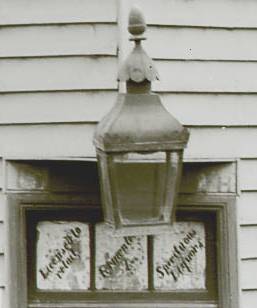

Thanks Lachlan, appreciate.
Shannon
G’day Lachlan,
I was just reading through your New Lambton Hotels article. In the March 2025 photo of the site of the New Lambton Hotel, I noticed sandstone gutters out the front of the “Bliss Body & Beauty Shop.” I was just wondering when you think those gutters might date back. I could be wrong, but I’m sure NCC has not been installing sandstone gutters in my lifetime. Looking at Google Map’s I see they also extend along the school along both Russell and Regent Street. Interested to know how old you think they might be?
Cheers
Shannon Hay
New Lambton Council was formed in 1889 and one of their first priorities was the forming of streets and making of gutters and kerbs as funds allowed. It is difficult to pin down an exact date for the kerbing at that location in Regent St, but a search of Trove shows that New Lambton council was pretty active with the kerbing of the main streets in the years 1890 to 1893.